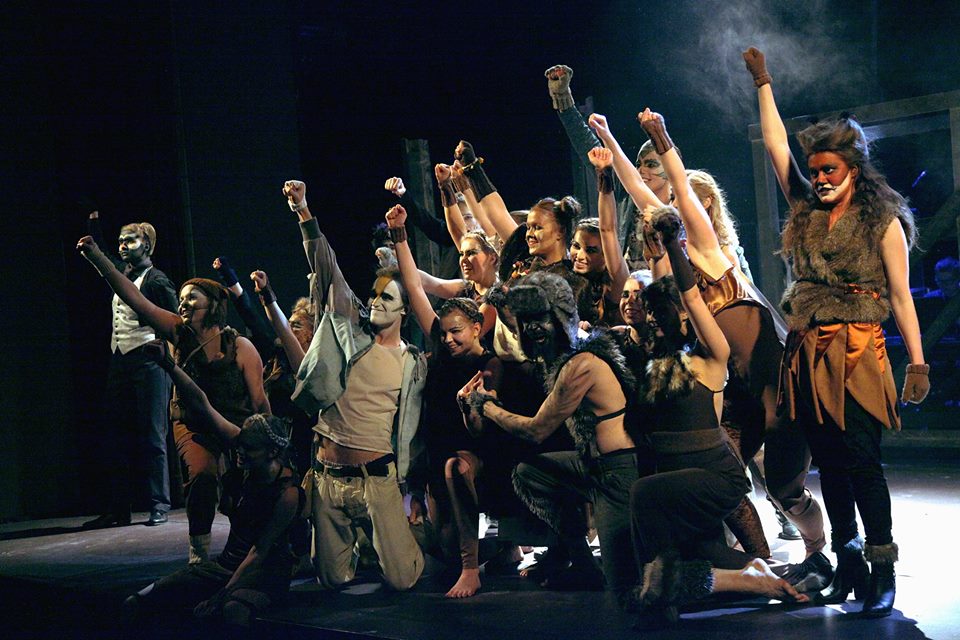Humanistispeksi 2016 Review: Seeing the Forest for the Trees
Some faculty speksis, or academic improv-musicals, enjoy cult statuses and their productions have no problems getting audience or commercial visibility. Humanistispeksi, or the annual Faculty of Art’s speksi, is however only a newbie in this field. This is the sixth Humanistispeksi in history and BTSB would not miss it for the world especially as over a dozen SUBbers and BTSB people were involved in the production. One thing Humanistispeksi – Metsä (Forest) cannot be praised enough for is the social media visibility before the show. From the beginning, it had a sense of professionalism that, along with its historical location at Kansallisteatteri, set expectations extremely high for the show.
The high expectations also pose a problem for reviewing the show: Speksis are in their very essence amateur theatre, but it would be intelligently dishonest to critique a production of this scale, with 130 people participating in the production, as an amateur production. Comparing it to professional theatre would be unfair as well, but simply taking it as yet another high-school musical does not seem right either. But balancing acts aside, from the furry-approved animal costumes to the hair and make-up work, this year’s speksi felt very professional.

Humanistispeksi, despite suffering some technical kinks in the beginning, managed to make the audience forget they were watching a non-pro production and made some real theatre magic happen. I felt the audience actually started to care about the main characters’ fates and lives, which can be quite rare for any piece of theatre.
The song selection was mostly good and some of the songs, such as the Queen, Dream Theater, and Apulanta covers, were magnificent. Also, the casting was spot on this year, and some actors deserve special acclaim, such as Hannu Hästbacka as the Seagull, Sonja Palmu as the Owl and Henrikki Pöntinen as Elias. However the star of the show is without a doubt Helena Lahtinen who plays Näkki. Her deep, Adele-like singing voice and her proud yet tender facade won the audience over right from the start.
What sets “our” speksi apart from other faculties’ speksis is the spontaneous, not rehearsed Omstart! -calls and I think all students in the humanities should be very proud of this. The improv skills of actors have amazed me from the very first Humanistispeksi on. Wednesday’s performance had some golden improv moments, but suffered from the flip side of the non-rehearsed omstarts: crappy hecklers. I mean, come on. The fact that you have the permission to yell in the middle of a theatre performance doesn’t mean you should do it all the frigging time. The idea of an “omstart” is to make people laugh and make the piece funnier, not to delay its story to the point where it’s only making you laugh. But the actors pulled through with grace and like I said, some of the omstarts were excellent, such as the role changes between two characters, the more sensual striking-in-the-head with a rifle butt, and, of course, the second rounds of the songs.
The main problem in this Humanistispeksi can be spotted already in the subheading (Free translation: “Help your enemy. Accept your fears. Break your world.”) – It is too long and too complex. There are wonderful elements, but the production suffers from the classic syndrome of not killing your darlings. Each of the wonderful animal characters deserve their own short animation movies, but giving every single character (over 20) their own spot in the show was simply too much. The play lasted over three hours and was thus painstakingly long. Add to that the extra applause rolls in the end that clearly belong to the final night, not the second, and you had exhausted audience members who started to really just want to get out and go home.
The transitions from one scene to the next needed work as well. I think that if this wasn’t a speksi, the slow and often quiet endings of scenes would have worked better, but now they felt stiff.
For the most part, Metsä followed the old fashioned tracks of classic American musicals. I was then surprised that several songs that came back to back were tremendously similar to each other, such as “Valon voitto” and “Metsäämme jää”. It was a shame that some of the more impressive songs, such as “Ikihonka” felt buried under other songs. The same happened with the dance numbers, there were simply too many and the ones that were great had the danger of being buried alive by the numbers. Also. What is up with those dancer costumes? Come on. They would have deserved something more designed and special.
Despite some of the negative aspects mentioned here, Metsä was an ensemble the audience enjoyed tremendously. Some final touches and more importantly the painful process of deleting scenes and songs would have improved it, but the joy that you could read from the student actors’ faces made up for it. The love for theatre was tangible in Humanistispeksi.
I also want to applaud the brave, Tom of Finland-styled, love story. Although my old, mean Master of Arts companion did point out that an allegoric reading of the play suggests that homosexuality cannot exist in the realm of reality, within family and home, but has to exist in a fairy tale world. However, it can also be stated that the play suggests that homosexuality is a natural fact and its “spirit” is accepted to the company of age-old animal spirits, to the realm of holiness and purity. Elias+Aleksi Fanfic on demand.
